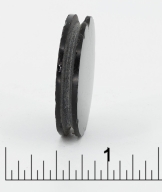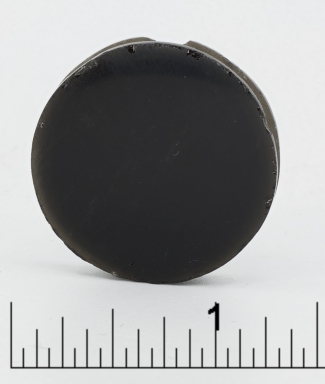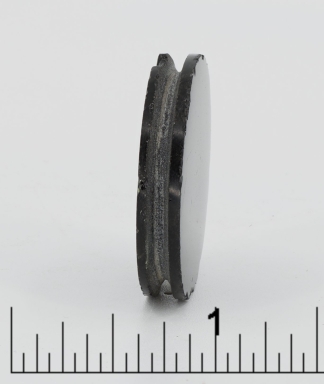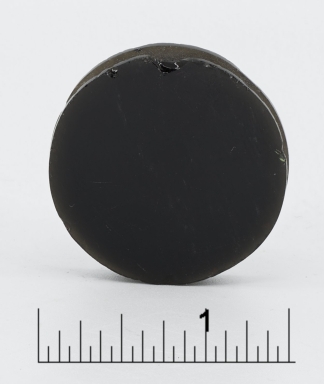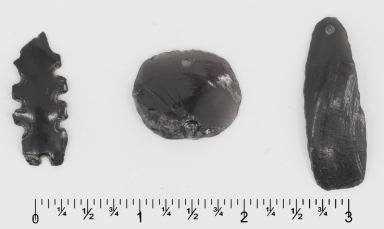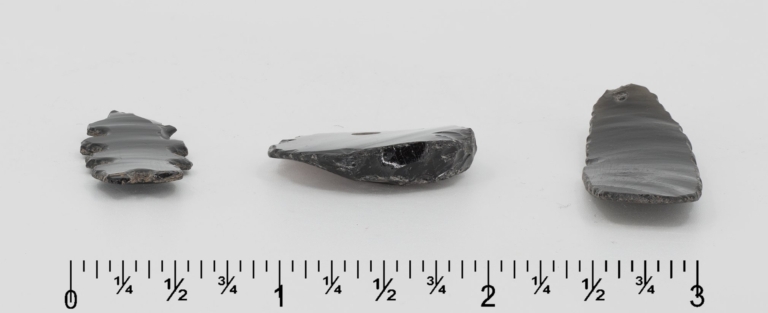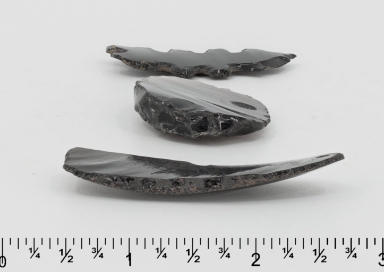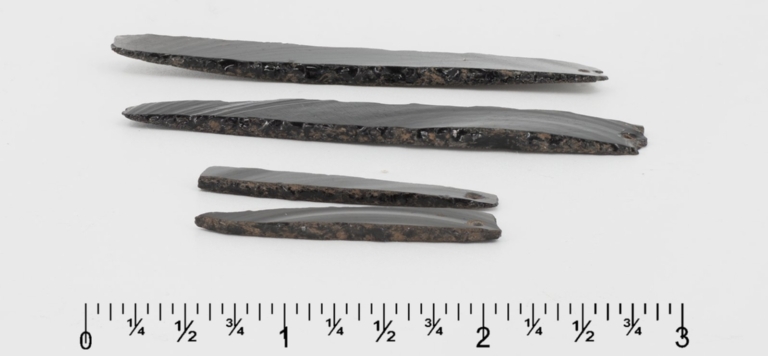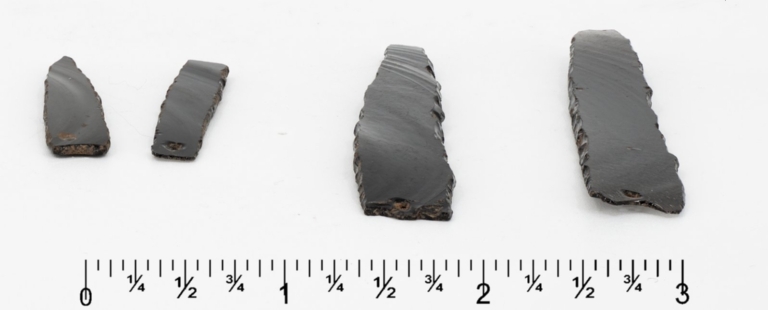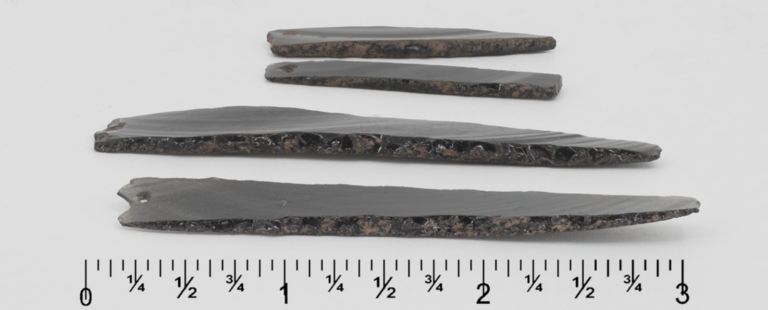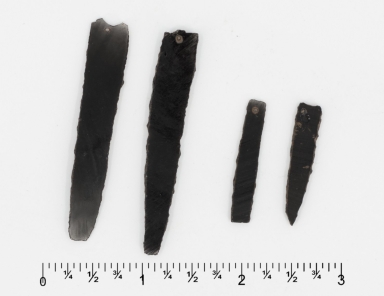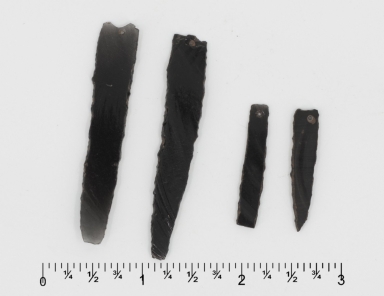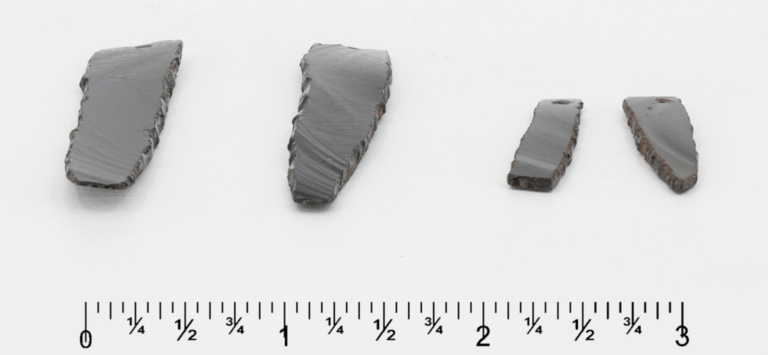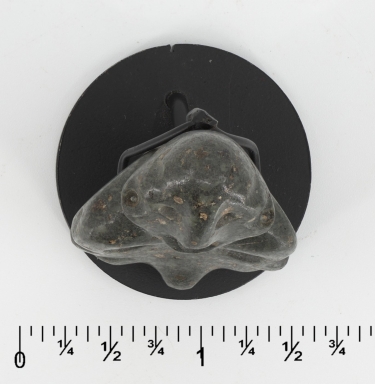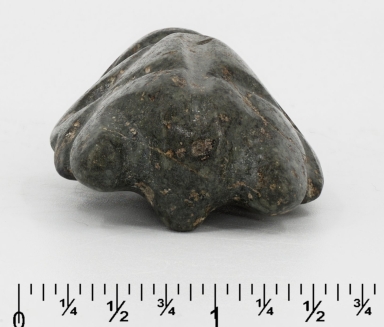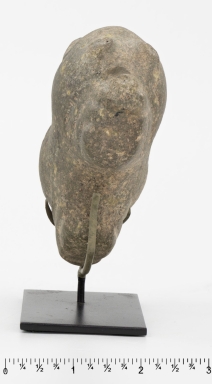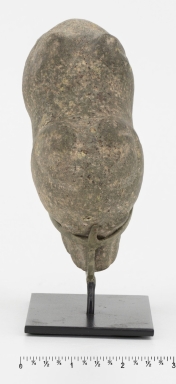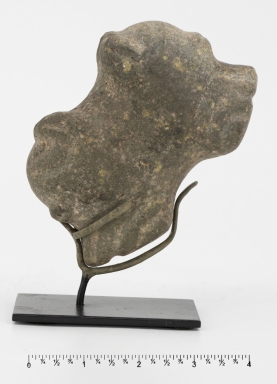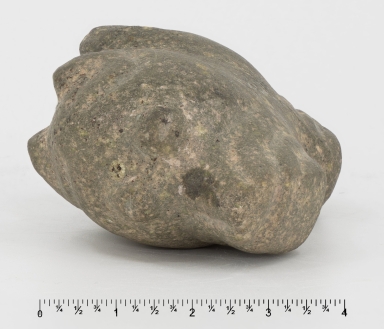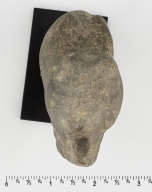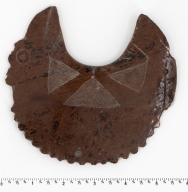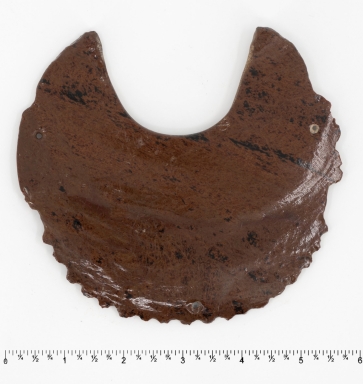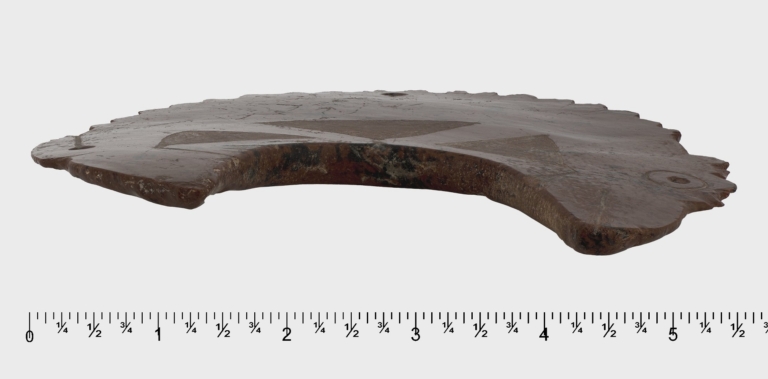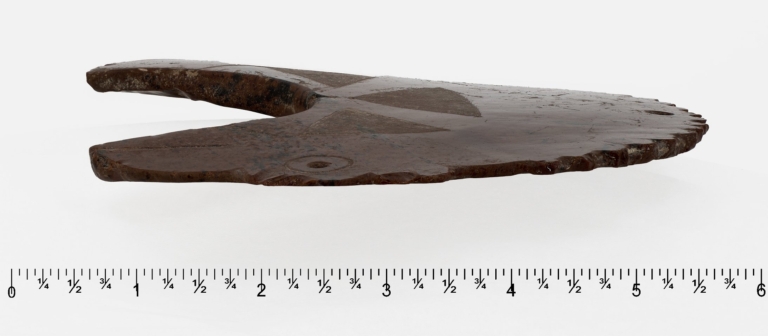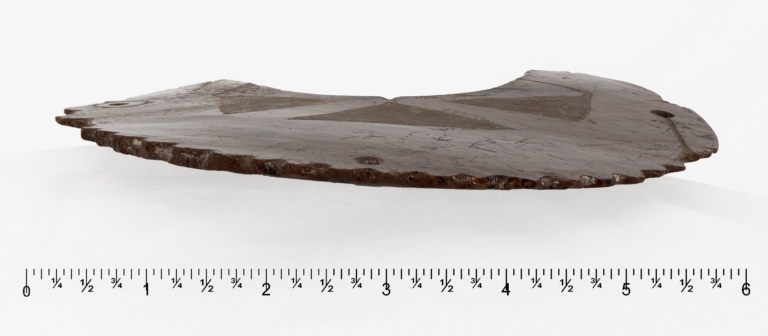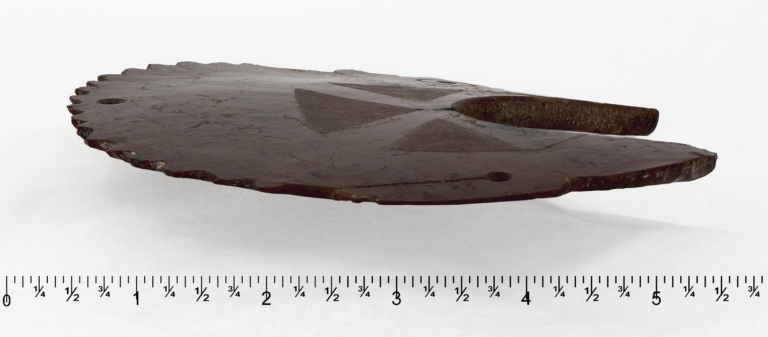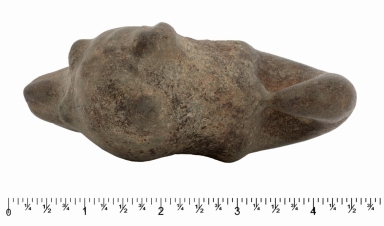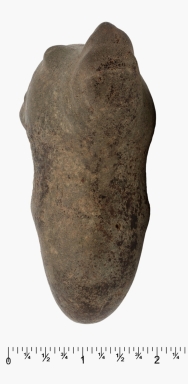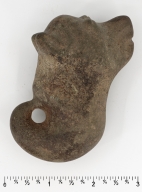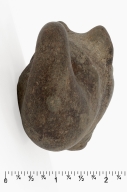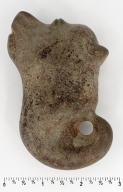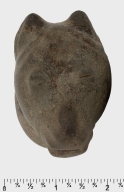Who What Where WhenWHAT
|
REFINE
Browse All : Stone carving--Mexico--Colima (State)
1-38 of 38
Title
Obsidian disc.
Description
Obsidian has been core flaked and pressure flaked to form a very cylinder. It was abraded and polished the perimeter was grooved wearing.
Subject
[Stone carving--Mexico--Colima (State), Obsidian, Indigenous peoples--Antiquities]
Date
between 1250 and 1521
Title
Obsidian disc.
Description
Obsidian has been core flaked and pressure flaked to form a very cylinder. It was abraded and polished the perimeter was grooved wearing.
Subject
[Stone carving--Mexico--Colima (State), Obsidian, Indigenous peoples--Antiquities]
Date
between 1250 and 1521
Title
Obsidian disc.
Description
Obsidian has been core flaked and pressure flaked to form a very cylinder. It was abraded and polished the perimeter was grooved wearing.
Subject
[Stone carving--Mexico--Colima (State), Obsidian, Indigenous peoples--Antiquities]
Date
between 1250 and 1521
Title
Obsidian disc.
Description
Obsidian has been core flaked and pressure flaked to form a very cylinder. It was abraded and polished the perimeter was grooved wearing.
Subject
[Stone carving--Mexico--Colima (State), Obsidian, Indigenous peoples--Antiquities]
Date
between 1250 and 1521
Title
Obsidian jewelry : pendants : nose ring with zoomorphic design.
Description
Disc: Obsidian blades are knocked off the core. They can be thick or thin depending on the skill of the knapper. This disc or mirror is so thin it is transparent. Teardrop pendant: The obsidian teardrop pendant is curved. The artist or knapper used the natural curve of the volcanic glass. The edges were pressure flaked and dulled with stones. The convex surface of the pendant has been smoothed with abrasive sands or grits. Nosering (zoomorphic design): This nose ring or nose ornament was shaped from a thin obsidian blade. The U-shaped notches were formed as part of the pressure flaking process. This broken nose ornament has an insect quality to its shape, even though the foil is missing.
Subject
[Jewelry--Mexico--Colima (State), Pendants (Jewelry)--Mexico--Colima (State), Nose rings--Mexico--Colima (State), Stone carving--Mexico--Colima (State), Indigenous peoples--Antiquities]
Date
between 250 BC and 250
Title
Obsidian jewelry : pendants : nose ring with zoomorphic design.
Description
Disc: Obsidian blades are knocked off the core. They can be thick or thin depending on the skill of the knapper. This disc or mirror is so thin it is transparent. Teardrop pendant: The obsidian teardrop pendant is curved. The artist or knapper used the natural curve of the volcanic glass. The edges were pressure flaked and dulled with stones. The convex surface of the pendant has been smoothed with abrasive sands or grits. Nosering (zoomorphic design): This nose ring or nose ornament was shaped from a thin obsidian blade. The U-shaped notches were formed as part of the pressure flaking process. This broken nose ornament has an insect quality to its shape, even though the foil is missing.
Subject
[Jewelry--Mexico--Colima (State), Pendants (Jewelry)--Mexico--Colima (State), Nose rings--Mexico--Colima (State), Stone carving--Mexico--Colima (State), Indigenous peoples--Antiquities]
Date
between 250 BC and 250
Title
Obsidian jewelry : pendants : nose ring with zoomorphic design.
Description
Disc: Obsidian blades are knocked off the core. They can be thick or thin depending on the skill of the knapper. This disc or mirror is so thin it is transparent. Teardrop pendant: The obsidian teardrop pendant is curved. The artist or knapper used the natural curve of the volcanic glass. The edges were pressure flaked and dulled with stones. The convex surface of the pendant has been smoothed with abrasive sands or grits. Nosering (zoomorphic design): This nose ring or nose ornament was shaped from a thin obsidian blade. The U-shaped notches were formed as part of the pressure flaking process. This broken nose ornament has an insect quality to its shape, even though the foil is missing.
Subject
[Jewelry--Mexico--Colima (State), Pendants (Jewelry)--Mexico--Colima (State), Nose rings--Mexico--Colima (State), Stone carving--Mexico--Colima (State), Indigenous peoples--Antiquities]
Date
between 250 BC and 250
Title
Obsidian jewelry : pendants : nose ring with zoomorphic design.
Description
Disc: Obsidian blades are knocked off the core. They can be thick or thin depending on the skill of the knapper. This disc or mirror is so thin it is transparent. Teardrop pendant: The obsidian teardrop pendant is curved. The artist or knapper used the natural curve of the volcanic glass. The edges were pressure flaked and dulled with stones. The convex surface of the pendant has been smoothed with abrasive sands or grits. Nosering (zoomorphic design): This nose ring or nose ornament was shaped from a thin obsidian blade. The U-shaped notches were formed as part of the pressure flaking process. This broken nose ornament has an insect quality to its shape, even though the foil is missing.
Subject
[Jewelry--Mexico--Colima (State), Pendants (Jewelry)--Mexico--Colima (State), Nose rings--Mexico--Colima (State), Stone carving--Mexico--Colima (State), Indigenous peoples--Antiquities]
Date
between 250 BC and 250
Title
Obsidian jewelry : earrings.
Description
Once a thin obsidian blade has been knocked off the core, it can be shaped by pressing off tiny pieces of the volcanic stone. The edges can be dulled by rubbing them with different stones. Holes are drilled for suspension. This pair of earrings was crafted this way.
Subject
[Earrings--Mexico--Colima (State), Jewelry--Mexico--Colima (State), Stone carving--Mexico--Colima (State), Indigenous peoples--Antiquities, Obsidian]
Date
between 250 B.C. and 250 A.D.
Title
Obsidian jewelry : earrings.
Description
Once a thin obsidian blade has been knocked off the core, it can be shaped by pressing off tiny pieces of the volcanic stone. The edges can be dulled by rubbing them with different stones. Holes are drilled for suspension. This pair of earrings was crafted this way.
Subject
[Earrings--Mexico--Colima (State), Jewelry--Mexico--Colima (State), Stone carving--Mexico--Colima (State), Indigenous peoples--Antiquities, Obsidian]
Date
between 250 B.C. and 250 A.D.
Title
Obsidian jewelry : earrings.
Description
Once a thin obsidian blade has been knocked off the core, it can be shaped by pressing off tiny pieces of the volcanic stone. The edges can be dulled by rubbing them with different stones. Holes are drilled for suspension. This pair of earrings was crafted this way.
Subject
[Earrings--Mexico--Colima (State), Jewelry--Mexico--Colima (State), Stone carving--Mexico--Colima (State), Indigenous peoples--Antiquities, Obsidian]
Date
between 250 B.C. and 250 A.D.
Title
Obsidian jewelry : earrings.
Description
Once a thin obsidian blade has been knocked off the core, it can be shaped by pressing off tiny pieces of the volcanic stone. The edges can be dulled by rubbing them with different stones. Holes are drilled for suspension. This pair of earrings was crafted this way.
Subject
[Earrings--Mexico--Colima (State), Jewelry--Mexico--Colima (State), Stone carving--Mexico--Colima (State), Indigenous peoples--Antiquities, Obsidian]
Date
between 250 B.C. and 250 A.D.
Title
Obsidian jewelry : earrings.
Description
Once a thin obsidian blade has been knocked off the core, it can be shaped by pressing off tiny pieces of the volcanic stone. The edges can be dulled by rubbing them with different stones. Holes are drilled for suspension. This pair of earrings was crafted this way.
Subject
[Earrings--Mexico--Colima (State), Jewelry--Mexico--Colima (State), Stone carving--Mexico--Colima (State), Indigenous peoples--Antiquities, Obsidian]
Date
between 250 B.C. and 250 A.D.
Title
Obsidian jewelry : earrings.
Description
Once a thin obsidian blade has been knocked off the core, it can be shaped by pressing off tiny pieces of the volcanic stone. The edges can be dulled by rubbing them with different stones. Holes are drilled for suspension. This pair of earrings was crafted this way.
Subject
[Earrings--Mexico--Colima (State), Jewelry--Mexico--Colima (State), Stone carving--Mexico--Colima (State), Indigenous peoples--Antiquities, Obsidian]
Date
between 250 B.C. and 250 A.D.
Title
Colima anthropomorphic, zoomorphic figure.
Description
The eyes, ears, mouth, and spine were inlaid in this figurative deep blue-green stone. The stone's image is obviously male, but less apparent are the secondary front and rear faces. Lay the stone stomach down, it transforms into a resting frog, the symbol of fertility. The stone transforms from a man to a frog and maybe a dog.
Subject
[Sculpture--Mexico--Colima (State), Stone carving--Mexico--Colima (State), Art--Mexico--Colima (State), Indigenous peoples--Antiquities]
Date
between 300 B.C. and 300 A.D.
Title
Colima anthropomorphic, zoomorphic figure.
Description
The eyes, ears, mouth, and spine were inlaid in this figurative deep blue-green stone. The stone's image is obviously male, but less apparent are the secondary front and rear faces. Lay the stone stomach down, it transforms into a resting frog, the symbol of fertility. The stone transforms from a man to a frog and maybe a dog.
Subject
[Sculpture--Mexico--Colima (State), Stone carving--Mexico--Colima (State), Art--Mexico--Colima (State), Indigenous peoples--Antiquities]
Date
between 300 B.C. and 300 A.D.
Title
Colima anthropomorphic, zoomorphic figure.
Description
The eyes, ears, mouth, and spine were inlaid in this figurative deep blue-green stone. The stone's image is obviously male, but less apparent are the secondary front and rear faces. Lay the stone stomach down, it transforms into a resting frog, the symbol of fertility. The stone transforms from a man to a frog and maybe a dog.
Subject
[Sculpture--Mexico--Colima (State), Stone carving--Mexico--Colima (State), Art--Mexico--Colima (State), Indigenous peoples--Antiquities]
Date
between 300 B.C. and 300 A.D.
Title
Colima anthropomorphic, zoomorphic figure.
Description
The eyes, ears, mouth, and spine were inlaid in this figurative deep blue-green stone. The stone's image is obviously male, but less apparent are the secondary front and rear faces. Lay the stone stomach down, it transforms into a resting frog, the symbol of fertility. The stone transforms from a man to a frog and maybe a dog.
Subject
[Sculpture--Mexico--Colima (State), Stone carving--Mexico--Colima (State), Art--Mexico--Colima (State), Indigenous peoples--Antiquities]
Date
between 300 B.C. and 300 A.D.
Title
Colima anthropomorphic, zoomorphic figure.
Description
The eyes, ears, mouth, and spine were inlaid in this figurative deep blue-green stone. The stone's image is obviously male, but less apparent are the secondary front and rear faces. Lay the stone stomach down, it transforms into a resting frog, the symbol of fertility. The stone transforms from a man to a frog and maybe a dog.
Subject
[Sculpture--Mexico--Colima (State), Stone carving--Mexico--Colima (State), Art--Mexico--Colima (State), Indigenous peoples--Antiquities]
Date
between 300 B.C. and 300 A.D.
Title
Colima anthropomorphic, zoomorphic figure.
Description
The eyes, ears, mouth, and spine were inlaid in this figurative deep blue-green stone. The stone's image is obviously male, but less apparent are the secondary front and rear faces. Lay the stone stomach down, it transforms into a resting frog, the symbol of fertility. The stone transforms from a man to a frog and maybe a dog.
Subject
[Sculpture--Mexico--Colima (State), Stone carving--Mexico--Colima (State), Art--Mexico--Colima (State), Indigenous peoples--Antiquities]
Date
between 300 B.C. and 300 A.D.
Title
Macehead : transforming images : 2.
Description
A macehead is a symbol of power, authority, and an object of destruction. The dog heads could represent food, companionship, warmth, or a guide or visitor to the underworld. Turn the macehead over and there are two horned frogs, a good source of a hallucinogenic drug. The poison allowed a shaman access to other worlds. The frog is associated with renewal, change, or transformation and fertility.
Subject
[Sculpture--Mexico--Colima (State), Stone carving--Mexico--Colima (State), Art--Mexico--Colima (State), Indigenous peoples--Antiquities]
Date
between 250 B.C. and 200 A.D.
Title
Macehead : transforming images : 2.
Description
A macehead is a symbol of power, authority, and an object of destruction. The dog heads could represent food, companionship, warmth, or a guide or visitor to the underworld. Turn the macehead over and there are two horned frogs, a good source of a hallucinogenic drug. The poison allowed a shaman access to other worlds. The frog is associated with renewal, change, or transformation and fertility.
Subject
[Sculpture--Mexico--Colima (State), Stone carving--Mexico--Colima (State), Art--Mexico--Colima (State), Indigenous peoples--Antiquities]
Date
between 250 B.C. and 200 A.D.
Title
Macehead : transforming images : 2.
Description
A macehead is a symbol of power, authority, and an object of destruction. The dog heads could represent food, companionship, warmth, or a guide or visitor to the underworld. Turn the macehead over and there are two horned frogs, a good source of a hallucinogenic drug. The poison allowed a shaman access to other worlds. The frog is associated with renewal, change, or transformation and fertility.
Subject
[Sculpture--Mexico--Colima (State), Stone carving--Mexico--Colima (State), Art--Mexico--Colima (State), Indigenous peoples--Antiquities]
Date
between 250 B.C. and 200 A.D.
Title
Macehead : transforming images : 2.
Description
A macehead is a symbol of power, authority, and an object of destruction. The dog heads could represent food, companionship, warmth, or a guide or visitor to the underworld. Turn the macehead over and there are two horned frogs, a good source of a hallucinogenic drug. The poison allowed a shaman access to other worlds. The frog is associated with renewal, change, or transformation and fertility.
Subject
[Sculpture--Mexico--Colima (State), Stone carving--Mexico--Colima (State), Art--Mexico--Colima (State), Indigenous peoples--Antiquities]
Date
between 250 B.C. and 200 A.D.
Title
Macehead : transforming images : 2.
Description
A macehead is a symbol of power, authority, and an object of destruction. The dog heads could represent food, companionship, warmth, or a guide or visitor to the underworld. Turn the macehead over and there are two horned frogs, a good source of a hallucinogenic drug. The poison allowed a shaman access to other worlds. The frog is associated with renewal, change, or transformation and fertility.
Subject
[Sculpture--Mexico--Colima (State), Stone carving--Mexico--Colima (State), Art--Mexico--Colima (State), Indigenous peoples--Antiquities]
Date
between 250 B.C. and 200 A.D.
Title
Macehead : transforming images : 2.
Description
A macehead is a symbol of power, authority, and an object of destruction. The dog heads could represent food, companionship, warmth, or a guide or visitor to the underworld. Turn the macehead over and there are two horned frogs, a good source of a hallucinogenic drug. The poison allowed a shaman access to other worlds. The frog is associated with renewal, change, or transformation and fertility.
Subject
[Sculpture--Mexico--Colima (State), Stone carving--Mexico--Colima (State), Art--Mexico--Colima (State), Indigenous peoples--Antiquities]
Date
between 250 B.C. and 200 A.D.
Title
Mahogany obsidian pectoral.
Description
This crescent-shaped pectoral has two pointed ends, which can be interpreted as a two-headed bird, a caiman, or an iguana. The pectoral represents duality and transformation.
Subject
[Stone carving--Mexico--Colima (State), Art--Mexico--Colima (State), Indigenous peoples--Antiquities]
Date
between 250 B.C. and 250 A.D.
Title
Mahogany obsidian pectoral.
Description
This crescent-shaped pectoral has two pointed ends, which can be interpreted as a two-headed bird, a caiman, or an iguana. The pectoral represents duality and transformation.
Subject
[Stone carving--Mexico--Colima (State), Art--Mexico--Colima (State), Indigenous peoples--Antiquities]
Date
between 250 B.C. and 250 A.D.
Title
Mahogany obsidian pectoral.
Description
This crescent-shaped pectoral has two pointed ends, which can be interpreted as a two-headed bird, a caiman, or an iguana. The pectoral represents duality and transformation.
Subject
[Stone carving--Mexico--Colima (State), Art--Mexico--Colima (State), Indigenous peoples--Antiquities]
Date
between 250 B.C. and 250 A.D.
Title
Mahogany obsidian pectoral.
Description
This crescent-shaped pectoral has two pointed ends, which can be interpreted as a two-headed bird, a caiman, or an iguana. The pectoral represents duality and transformation.
Subject
[Stone carving--Mexico--Colima (State), Art--Mexico--Colima (State), Indigenous peoples--Antiquities]
Date
between 250 B.C. and 250 A.D.
Title
Mahogany obsidian pectoral.
Description
This crescent-shaped pectoral has two pointed ends, which can be interpreted as a two-headed bird, a caiman, or an iguana. The pectoral represents duality and transformation.
Subject
[Stone carving--Mexico--Colima (State), Art--Mexico--Colima (State), Indigenous peoples--Antiquities]
Date
between 250 B.C. and 250 A.D.
Title
Mahogany obsidian pectoral.
Description
This crescent-shaped pectoral has two pointed ends, which can be interpreted as a two-headed bird, a caiman, or an iguana. The pectoral represents duality and transformation.
Subject
[Stone carving--Mexico--Colima (State), Art--Mexico--Colima (State), Indigenous peoples--Antiquities]
Date
between 250 B.C. and 250 A.D.
Title
Macehead : transforming images : 4.
Description
A macehead can symbolize power and authority, but this macehead represents transformation. All the animals depicted on this macehead have the ability to move symbolically or physically from the underworld to the living world to the heavens of gods and ancestors. Individually, they represent different concepts: abundance, fertility, rebirth, renewal, and transformation.
Subject
[Stone carving--Mexico--Colima (State), Sculpture--Mexico--Colima (State), Art--Mexico--Colima (State), Indigenous peoples--Antiquities]
Date
between 300 B.C. and 300 A.D.
Title
Macehead : transforming images : 4.
Description
A macehead can symbolize power and authority, but this macehead represents transformation. All the animals depicted on this macehead have the ability to move symbolically or physically from the underworld to the living world to the heavens of gods and ancestors. Individually, they represent different concepts: abundance, fertility, rebirth, renewal, and transformation.
Subject
[Stone carving--Mexico--Colima (State), Sculpture--Mexico--Colima (State), Art--Mexico--Colima (State), Indigenous peoples--Antiquities]
Date
between 300 B.C. and 300 A.D.
Title
Macehead : transforming images : 4.
Description
A macehead can symbolize power and authority, but this macehead represents transformation. All the animals depicted on this macehead have the ability to move symbolically or physically from the underworld to the living world to the heavens of gods and ancestors. Individually, they represent different concepts: abundance, fertility, rebirth, renewal, and transformation.
Subject
[Stone carving--Mexico--Colima (State), Sculpture--Mexico--Colima (State), Art--Mexico--Colima (State), Indigenous peoples--Antiquities]
Date
between 300 B.C. and 300 A.D.
Title
Macehead : transforming images : 4.
Description
A macehead can symbolize power and authority, but this macehead represents transformation. All the animals depicted on this macehead have the ability to move symbolically or physically from the underworld to the living world to the heavens of gods and ancestors. Individually, they represent different concepts: abundance, fertility, rebirth, renewal, and transformation.
Subject
[Stone carving--Mexico--Colima (State), Sculpture--Mexico--Colima (State), Art--Mexico--Colima (State), Indigenous peoples--Antiquities]
Date
between 300 B.C. and 300 A.D.
Title
Macehead : transforming images : 4.
Description
A macehead can symbolize power and authority, but this macehead represents transformation. All the animals depicted on this macehead have the ability to move symbolically or physically from the underworld to the living world to the heavens of gods and ancestors. Individually, they represent different concepts: abundance, fertility, rebirth, renewal, and transformation.
Subject
[Stone carving--Mexico--Colima (State), Sculpture--Mexico--Colima (State), Art--Mexico--Colima (State), Indigenous peoples--Antiquities]
Date
between 300 B.C. and 300 A.D.
Title
Macehead : transforming images : 4.
Description
A macehead can symbolize power and authority, but this macehead represents transformation. All the animals depicted on this macehead have the ability to move symbolically or physically from the underworld to the living world to the heavens of gods and ancestors. Individually, they represent different concepts: abundance, fertility, rebirth, renewal, and transformation.
Subject
[Stone carving--Mexico--Colima (State), Sculpture--Mexico--Colima (State), Art--Mexico--Colima (State), Indigenous peoples--Antiquities]
Date
between 300 B.C. and 300 A.D.
1-38 of 38
|
